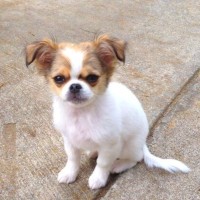Appearance of the Chin-wa
|
| The Chin-wa is a cross between a Japanese Spaniel and a Chihuahua. They are toy breeds, rarely weighing more than 4 kilos and measuring around 28 centimeters in height. They are generally brown, red, cream, black, white and gray, and their coats can be short or long and straight. The tail usually curls over the dog's back. The eyes are often large, as both parent breeds are known for their expressive eyes that dominate the face. The head is often apple-shaped like the Chihuahua, and may be adorned with ears that are more floppy like the Chin, or erect like the Chihuahua. |
Temperament of the Chin-wa
|
| A Chin-wa is likely to adopt many traits of the parent breeds and is therefore likely to make an excellent pet, preferably with older children. They are alert and loyal and like nothing more than to be with the family, so should not be left alone for any length of time. Because of their stubborn tendency, Chin-wa should be trained and socialized from an early age to avoid problems forming later on. The breed doesn't need much exercise to stay fit and healthy, but a walk twice a day for fresh air and play sessions will also keep your pet happy and mentally stimulated. Happy to live in an apartment, your hybrid will need to be taken out daily. They're lively dogs who like to do tricks, so they need to be encouraged. They are good with other animals, provided they are socialized early and make good pets for new owners. |
Needs and activities of the Chin-wa
|
| Your Chin-wa won't need much exercise to stay happy and healthy, but it may bark if bored. It will also be good for socialization opportunities. They should be walked on a leash as they are quite stubborn and won't necessarily come when you call them. These dogs are very good for apartment dwellers as they are happy with indoor play sessions and will enjoy playing with their toys. They don't like the cold, so make sure they're warm in winter and not left outside for any length of time. |
Maintenance of the Chin-wa
|
| None of the parent breeds are hypoallergenic, so your Chin-wa won't be either, which is something to bear in mind if there are allergies in the family. Your dog needs moderate grooming to keep it looking good and not shedding much, although whether it has short or long hair will also affect this. Your pet shouldn't need brushing more than once a week, but it stimulates the skin and keeps the coat healthy when you do. Smaller breeds may have teething problems and are prone to tooth decay, so it's best to brush their teeth every day. Start when your Chin-wa is young and he won't mind the short cleaning routine at all. The same goes for nails: trim them often and your hybrid will be used to the regime. |









 English (United Kingdom)
English (United Kingdom)